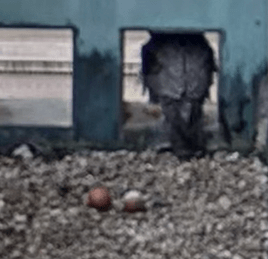After some concerns about the balcony being flooded, our falcon duo has surprised us with eggs! The first one may have been laid some time Saturday night/Sunday morning. As of this morning, there is a second egg!
Not having observed this phenomenon before, I was a little concerned about them not being brooded and getting too cold, so I reached out to Barb Baldinger, a colleague who used to help the Michigan DNR Southeastern Michigan peregrine monitor, and asked if this was ok. She responded that they will not start incubating the eggs until the second from last or last egg is laid to make sure they all hatch around the same time.
Eggs are typically laid two to three days apart. Why the delay? After an oocyte (unfertilized) egg cell is released from the ovary, it goes through a series of stages to develop the layers of yolk, albumen (the white stuff in the eggs we eat), protective membranes and the shell. This takes about 48 hours. If it is fertilized before this begins, then there could be a chick. This Raptor Resource Project website has a great explanation (for bald eagles, but it’s basically the same for the peregrines), with illustrations, if you want all the details!

Peregrines will typically lay three or four eggs, but a new young couple like ours might only have two. Incubation will take about a month. The male and female will share this duty. The young will hatch over a period of a few days. The female will tend to stay on the nest more toward the end of the incubation period and the male will bring her food.
Exciting times ahead! Keep watching for further developments, and stay in touch!
Watch our #WSUFalcons live at go.wayne.edu/falcons.

So glad you have a blog!! I saw the ledge when it was flooded. I sure hope drainage was checked and/or more gravel was added…if not, there’s a huge risk during the next downpour. Having watched this happen on another ledge, years ago, it was tragic for the chicks. rescue was attempted, but sadly, it was too late….so, fingers crossed there will be no new puddles.
3 eggs now!!! YAY
Thank you for checking in! It does look like they moved the nesting area up higher onto the gravel and away from the shallow depression that had been created, so hopefully that will help. As we no longer have a coordinator from the DNR working with us, we did not make any amendments to the site last fall, but will definitely add gravel this fall!
Keep an eye on things and keep in touch! Take care!